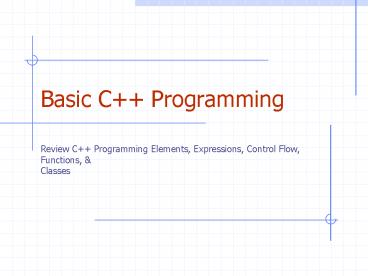Basic C Programming - PowerPoint PPT Presentation
1 / 10
Title:
Basic C Programming
Description:
Writing a C Program ( 1.7) There are 3 fundamental steps to ... development environment (IDE) like Borland C Builder) ... with Borland C ... – PowerPoint PPT presentation
Number of Views:130
Avg rating:3.0/5.0
Title: Basic C Programming
1
Basic C Programming
Review C Programming Elements, Expressions,
Control Flow, Functions, Classes
2
Writing a C Program ( 1.7)
- There are 3 fundamental steps to writing a C
program - Design
- Coding
- Testing and Debugging
3
Design ( 1.7.1)
- Perhaps most important step!
- Determine classes
- how they will interact
- data each will store
- actions each will perform
4
Class Design Rules of Thumb ( 1.7.1)
- Responsibilities Divide the work into different
actors - each with a different responsibility
- describe responsibilities using action verbs
- actors will form the classes
- Independence Keep work of classes as independent
as possible - Behaviors Define behaviors of each class
carefully and preciselythese will define member
functions (the set of behaviors may be called a
protocol).
5
Coding ( 1.7.2)
- Once design phase completed, create actual code
for the classes (using integrated development
environment (IDE) like Borland CBuilder). - Compile into working code
- fix any identified syntax errors
- Run program!
6
Readability and Style ( 1.7.2)
- Programs should be easy to read and understand
- Use meaningful names for identifiers.
- Can be read aloud and reflect the action,
responsibilty, or data - capitalize first letter unless for a variable or
method - Date Vector identify classes
- isFull() studentName identify a member
function variable - Use named constants and enumerations
- Indent statement blocks.
- Organize each class in a consistent order.
- private properties
- private/protected member functions
- public member functions
- Use comments that add meaning and explain
confusing constructs.
7
Testing Debugging ( 1.7.3)
- Testing
- process of verifying the correctness of program
- Debugging
- process of tracking execution of program and
discovering errors in it - Most time-consuming activity in program
development!
8
Testing ( 1.7.3)
- A careful testing plan is essential.
- Often impossible to verify correctness over all
possible inputs - Select a representative subset of test values
- Method coverage
- Every method tested at least once
- Statement coverage (better)
- Every statement executed at least once
- Check special cases.
9
Testing Arrays ( 1.7.3)
- For example, suppose you are testing a method
that sorts an array of integers. - Test with an empty array
- Test with an array of length 1
- Test when all elements of the array are equal
- Test when array already sorted
- Test when array in reverse order
- Also with arrays,
- Test that boundary/end values are handled
properly - Test with fixed values as well as randomly
generated/user defined values
10
Debugging ( 1.7.3)
- Possible techniques
- Use print statements (cout ltlt x) to track
variable values during execution - simplest technique
- problem these statements must be deleted or
commented out later before program could be
executed as desired - Use a debugger
- better approach
- a specialized environment for controlling and
monitoring program execution - insert breakpoints within codeexecution stops at
each, and current values of variables can be
observed - Investigate with Borland C Builder































